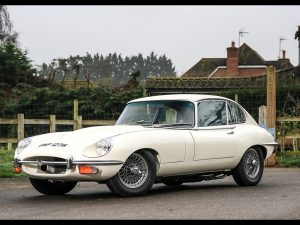The Jaguar E-type bodywork – structural and of course cosmetic – is the prime concern with any Jaguar E-type. Many would say it`s more important than even the mechanical condition. Purely because the high level of the investment that`s involved, a thorough inspection by a Jaguar E-type professional would be our recommendation, to be sure it represents value for your money. The restoration cost can very soon exceed your car’s total value. For example the design that incorporates large monocoque / chassis box sections, is prone to rust, this is a result of some internal condensation. If you`re brave enough to make your very own inspection take a close look about the front chassis, the frame cracking is a sign of serious internal rot that`s breaking through. Check out the outer sills, see if the drain holes are doing their job, and haven`t been blocked by enthusiastic use of the undersealing. Pay particular attention to panel gaps, as the wings might not be welded on correctly, this is not a matter of some adjustment to fix.
The 4.2-litre straight six Jaguar E-type engine is very strong and very reliable but, the cylinder block is very susceptible to some frost damage, so do look out for cracks. Cylinder blocks can be metal stitched at high cost. If the tappet noise is quite excessive and does continue for a while after starting the engine, then the tappet-guides might need replacing. Some other things you want to look for are; wear on the gearbox main shaft, and gearboxes with a synchromesh problem, and there`s a tendency for the brake master cylinder to stick too.
Jaguar E-type steering column bush and the rack end bushes quite often wear out, as do the ball joints. Many US Jaguar cars had the genuine factory power-steering system fitted. The original 16in steering wheels constricted the drivers, so as a result, a smaller after-market type have been often substituted. The original Jaguar E-type wooden steering wheels often delaminate and do split.
Many Jaguar E-type series II drivers actually prefer the silver wire spoked wheels, as the chrome wheels (an option) were often found on the US cars. The rear wheel-bearings and the rear differentials are temperamental, but parts are very available and not expensive, although the replacement is very involved and so therefore very costly. The Series II E-type wheel hubs are quite smooth and much stronger than their predecessors. A few cars will of course been fitted with more modern tyres, along with wider rims, probably for the improved handling, but look for any signs of rubbing in the wheel arches. Make sure too that the spanner tool that`s for the wheel spinners is with the car.
Many Jaguar E-types return to the UK mainly from the USA, conversions from left hand to right hand drive will greatly affect the value. To meet strict emission levels, the Americans were delivered detuned engines, using the twin Zenith Stromberg 175CDSE carburettors, but triple SUHD8s were used in the UK. The retro fitting of the SU carburettor set-up is a very good upgrade to a USA market car.
While the Jaguar E-type purists hanker for the Series I car, the Series II E-type had incorporated a large number of very significant improvements which resulted in a more reliable car.
Now, because the USA represented such a huge market for the Jaguar E-type, most the changes were in-line with the US legislation that was relating to the emissions and the safety. An example, new fully-reclining seats that allowed for the head-restraints to be fitted. The rocker switches were replaced with the much earlier toggle-type, and also the collapsible steering wheel was then introduced. But, astonishingly the most dramatic visible change was to be the loss of the E-type distinctive headlight glass covers.
The engine cooling was much improved with a very large air intake, and a big pair of electric controlled cooling fans mounted to a large radiator. The braking was much improved, the air conditioning in the left hand-drive cars, and the power-steering were only options, with the auto-gearbox the being the factory-fitted option for the Jaguar E-type 2+2 owners.
Those who wanted a fully sorted Jaguar E-type, the Series IIE-type has so much going for it. Real good examples won`t be cheap, but you will be investing in one, if not “the” most desirable of classic cars.

